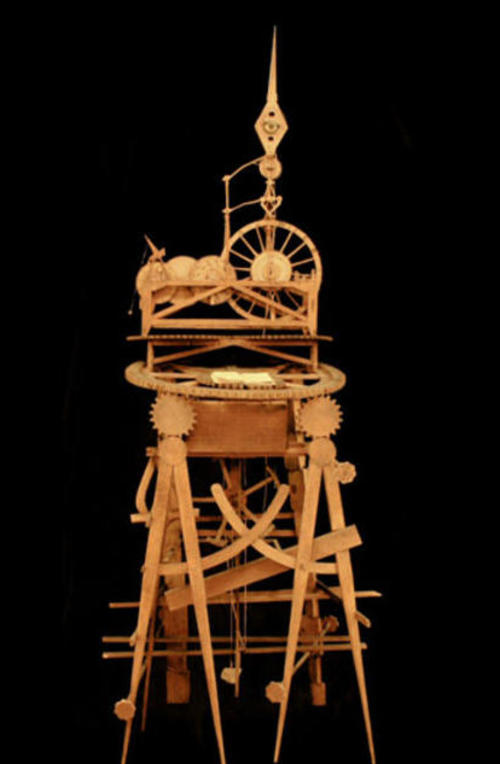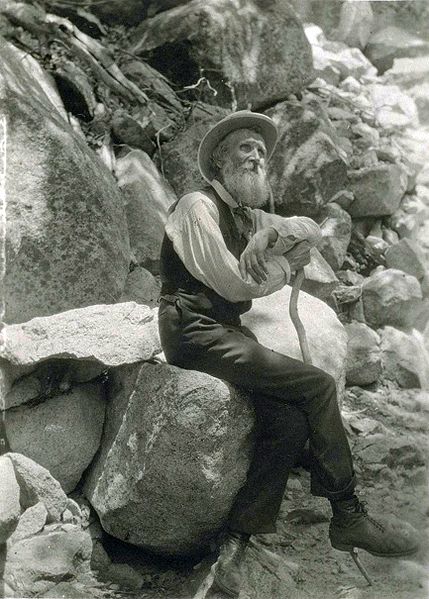It’s 1 a.m. and John is awake. He knows what will happen but has no desire to stop it.
The tick tick tick of the clockwork device sounds like hail upon the windowpane. Any second it will go off.
Bam! The device kicks a stone attached to the leg of his bed. The bed crashes down and throws John to the floor.
He leaps up, rushes to the freezing cellar where his clockwork desk opens a book and rotates it to him.
An hour later, the book closes and the next one rotates into focus. Algebra, geometry, trigonometry, Shakespeare, and ah! Emerson.
“I gained five hours, almost half a day!” he wrote. “’Five hours to myself!’…I can hardly think of any other event in my life, any discovery I ever made that gave birth to joy so transportingly glorious as the possession of these five frosty hours.”
Is this the opening of my new Steampunk novel?
No, it’s a true chapter from the life of naturalist John Muir (1838-1914), best known for establishing California’s Yosemite National Park and founding the Sierra Club.
He dreamed up machines to better people’s lives, until a blinding epiphany changed his.

A Brave New World
John Muir was born in Dunbar, Scotland, 177 years ago today, the son of a religious fanatic named Daniel.
One evening Daniel told his children to forget their homework and start packing. “Bairns,” he said, “you needna learn your lessons the nicht, for we’re gan to America the morn!”
Daniel would answer no questions and demanded complete obedience. Although surprised, John (age 11) and his younger brother were ecstatic, until introduced to their father’s idea of a brave new world.
“We were all made slaves,” Muir later wrote. Daniel expected them to carve out a farm from the Wisconsin wilderness.
John’s duty was to burn brush in preparation for plowing. His father stood by his side and said, “What an awful thing it would be to be thrown into that fire:—and then think of hellfire, that is so many times hotter. Into that fire, all bad boys will be cast…”
No wonder John developed an obsession with machines, rising every morning at 1 a.m. so he could study and invent. Starting at 6 a.m., he performed his back-breaking farm chores between beatings.
“The old Scotch fashion of whipping for every act of disobedience or of simple, playful forgetfulness was still kept up to in the wilderness, and of course many of these whipping fell upon me. Most of them were outrageously severe, and utterly barren of fun.”
At age 22, when one of his inventions won a prize at the State Fair, John escaped and enrolled at University of Wisconsin, Madison. His first botany class under a majestic black locust tree outside North Hall gave him new purpose.
“This fine lesson charmed me and sent me flying to the woods and meadows in wild enthusiasm.”
Finally happy in his own brave world, John meandered through his courses. College records showed his status as “irregular gent.”
Many biographies gloss over why he dropped out — to avoid the Civil War draft. He joined his brother in Canada, and spent spring, summer, and fall collecting plants in the woods and swamps around Lake Huron. That winter, he took a job in a sawmill and stayed for almost a year.
After the war, John became a sawyer for $22 a week in a wagon wheel factory.
Blindsided by Destiny
One evening, John was working on a belt with a long file. Somehow, it slipped and rebounded across his eye. “My right eye is gone. Closed forever on all God’s beauty!”
A specialist was called. John’s cornea was badly damaged. But if he rested, he might see again.
John locked himself in a darkened room and dreamed of woods and forests. He vowed if his sight returned, he would “be true to myself” and spend his life exploring and studying plants.
“This affliction has driven me to the sweet fields. God has to nearly kill us sometimes, to teach us lessons.”
Six weeks later, the doctor removed his bandages. He could see! As soon as his vision stabilized, he took to the woods.
In September 1867, John walked 1000 miles from Indiana to Florida, sailed to Cuba and Panama, then crossed the Isthmus on a pilgrimage to California and the world’s oldest and largest trees, the Sequoias.
In March 1868, John arrived in San Francisco and immediately departed for Yosemite Valley with a companion he’d met on the ship. It took them a month to get there, but a grizzly scared them out a few days later.
John then became an itinerant farm hand, a ferry pilot and a sheep shearer, all in an effort to return to Yosemite.
Finally, the Upper Hotel, located near the base of Yosemite Falls, hired him to cut logs for their expansion. He built himself a cabin on on Yosemite Creek. (Later, the U.S. Supreme Court declared Yosemite Valley a National Park and bought the hotel out.)
After John completed the project, he stayed in Yosemite for another 10 years and became a local guide and legend. Some people saw him as the wise man of the mountain. Artists, scientists, and celebrities sought him out.
Others assumed he was an unemployed bum.
In 1871, John’s hero, Ralph Waldo Emerson, visited Yosemite. The two spent the day together and Emerson offered John a position at Harvard’s Divinity School. “I never for a moment thought of giving up God’s big show for a mere profship!” John later wrote.
As he entered his 40s, friends encouraged him to settle down. John moved to Oakland and met Louisa Strentzel, daughter of a prominent physician. They married and managed her father’s 2,600 acre fruit orchard. John was not happy about being a farmer again, but the ranch thrived under his care.
Luckily, Louisa understood him well and packed him off to the mountains whenever he drove her nuts. They had two daughters who often accompanied him as they grew older.
In 1892, John helped found the Sierra Club, which successfully campaigned to put Yosemite Valley under federal protection. He remained its president for 22 years.
Over the course of his career, John wrote over 300 lyrical, luminous newspapers and magazine essays defending his beloved open spaces:
“Thousands of tired, nerve-shaken, over-civilized people are beginning to find out that going to the mountains is going home; that wilderness is a necessity; and that mountain parks and reservations are useful not only as fountains of timber and irrigating rivers, but as fountains of life.”

At age 74, he published his memoir, My First Summer in the Sierra, and took a trip to South America. He journeyed by horseback into a forest of monkey puzzle trees.
A year later, he sailed for Africa without telling his daughters, for fear they’d try to stop him. His purpose—to see the baobob trees. He camped at Victoria Falls, then hired a child to take him to a grove of baobob. “Kings may be less,” he wrote to his daughters (imagine their surprise), “but I am glorious!”
Father of Steampunk?
In 1863, Jules Verne began writing about fantastical inventions we now identify with Steampunk. Five years earlier, John Muir was building them.
Yet we remember John Muir for his fierce devotion to nature, not the wacky clockwork machines he refused to patent because he wanted everyone to benefit. Still, if Muir had gone into the woods and never come out, we wouldn’t know Yosemite, Sequoia, or other places of natural beauty.
Muir was a walker between worlds all his life, like many Later Bloomers. It’s part of the natural beauty of our path.
John Muir’s birthday falls on April 21 and Earth Day is April 22. What’s the most innovative thing you’ve done to lower your ecological footprint?
Sources
- The excellent biographies John Muir: Nature’s Visionary by Gretal Ehrlich and A Passion for Nature by Donald Worster.
- John Muir’s writings are in the public domain. They’re free on Amazon and at Gutenberg. All quotes of his younger days are from The Story of My Boyhood and Youth.
- Opening Image: Giant Redwood Trees of California by Albert Bierstadt (1874)
